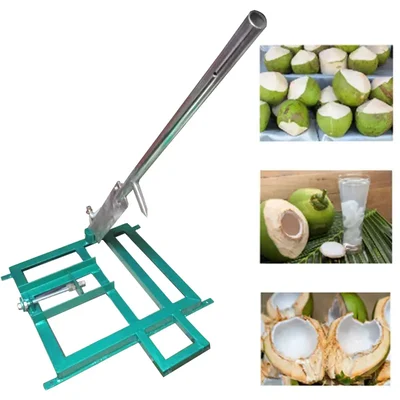- Farm & Garden
- Pumps & Motors
- Food Processing
- Workshop, DIY & MRO
- Lab & Measuring Tools

Brand: Generic ( Made in India )
Portable Tabletop Square Shape SS Blade Tender Coconut Cutting Machine
SKU: TI-CM-15716
 19 people have bought this recently
19 people have bought this recently  Delivery By: Dec 21 - Dec 23
Delivery By: Dec 21 - Dec 23 





MRP : ₹6990 ₹4896
30% OFF!

 19 people have bought this recently
19 people have bought this recently  Delivery By: Dec 21 - Dec 23
Delivery By: Dec 21 - Dec 23 

Easy Return
& Refund
& Refund

Quality
Assurance
Assurance

Trusted
Delivery
Delivery

After Sales
Assistance
Assistance

Buyer
Protection
Protection
₹4896 (Including GST)
MRP : ₹6990
30% OFF!
Get Extra ₹73 OFF on Prepaid Orders
QTY :
-
1
+
Short Description
Hand-operated, portable coconut cutting machine with a stainless steel blade and mild steel body, ideal for easily opening tender coconuts. Made in India.
Country of origin: India
Specifications
- Brand: Generic ( Made in India )
- Weight (Approx.) : 7 kg
- Automation Grade: Hand Operated
- Body Material: Mild Steel (High Grade MS)
- Blade Material: Premium Stainless Steel (Rust free and useful for non-stop usage)
- Recommended for: Coconut Cutting
- Colour: Green
- Weight: 7 Kg (Approx.)
- Brand: Generic (Made in India)
Description
This portable tabletop tender coconut cutting machine is a manually operated device designed for efficiently opening tender coconuts. Constructed with a durable mild steel body and a rust-free premium stainless steel blade, it ensures longevity and suitability for continuous use. Its square shape and tabletop design offer stability during operation. Being hand-operated, it provides a simple and reliable solution for accessing the refreshing water and soft flesh of tender coconuts. This product is proudly made in India.
Features
:Applications
:This versatile hand-operated coconut cutting machine finds its utility in a range of settings where fresh tender coconuts are served or processed:
- Residential Use: For coconut enthusiasts at home, this machine offers a convenient and less messy way to enjoy tender coconut water and flesh. It eliminates the need for potentially dangerous knives or cleavers, making it a safer option for regular consumption. Imagine easily opening a refreshing coconut on a hot afternoon without the hassle.
- Small-Scale Commercial Establishments:
Small Restaurants and Cafes: Establishments that offer fresh coconut water or use tender coconut flesh in their dishes can benefit from this machine. It provides a consistent and easy way to prepare coconuts for various culinary applications, ensuring a fresh supply of ingredients.
Catering Services: For events and gatherings, this portable machine allows caterers to offer fresh coconut water as a healthy and refreshing beverage option. Its manual operation means it doesn't rely on electricity, making it suitable for outdoor or remote locations.
- Tourism and Hospitality:
Beachside Vendors: Its portability and manual operation make it well-suited for beach vendors catering to tourists seeking a natural and hydrating drink.
- Agricultural and Processing Units (Small Scale): While not for large-scale industrial processing, small farms or local processing units might find this machine useful for opening a limited number of tender coconuts for direct sale or for extracting small quantities of coconut water and flesh for specific products.
- Community Events and Festivals: During local fairs or festivals, vendors can use this machine to offer a refreshing and natural beverage option to attendees.
Usage
:Preparation and Placement:
- Select a firm and level surface to place the coconut cutting machine. This ensures stability and prevents accidents during operation.
- Ensure the machine is clean before use.
- Have a tender coconut ready for cutting.
- Most machines of this type will have a holding mechanism or a stable base to place the coconut on. Position the coconut securely so it doesn't wobble or slip during the cutting process. Some may have adjustable arms or supports to accommodate different sizes of coconuts.
- Identify the lever or handle that controls the movement of the stainless steel blade.
- Grip the lever/handle firmly with one or both hands, depending on the design and the force required.
- With a smooth and controlled motion, bring the blade down onto the top of the tender coconut where you intend to create the opening.
- Apply steady and even pressure. Avoid jerky or sudden movements. The sharpness of the stainless steel blade should allow it to penetrate the husk and shell with moderate force.
- Continue applying pressure until the blade has cut through the top portion of the coconut, creating a sufficient opening to access the water and flesh. The design of the machine might dictate the shape and size of the opening.
- Carefully lift the lever/handle to retract the blade.
- Remove the cut-off top portion of the coconut. You can now enjoy the fresh coconut water directly or scoop out the tender flesh.
- Promptly clean the blade and any parts of the machine that came into contact with coconut water or flesh to prevent sticking and maintain hygiene.
Maintenance:
Consistent maintenance is crucial for the longevity and efficient operation of your coconut cutting machine:
Daily Cleaning:
- Blade: Immediately after each use, wipe the stainless steel blade with a clean, damp cloth to remove any coconut residue. For sticky residue, use a mild soapy solution, then rinse with clean water and dry thoroughly. Pay attention to the edges and crevices where debris might accumulate.
- Body: Wipe down the mild steel body with a damp cloth to remove any splashes or spills. Dry it thoroughly to prevent rust.
- Holding Mechanism: Clean any parts that held the coconut to remove any sticky residue.
- For a more thorough cleaning, you might need to disassemble certain parts of the machine (refer to the manufacturer's instructions if available).
- Wash removable parts with warm soapy water, rinse thoroughly, and ensure they are completely dry before reassembling.
- Inspect for any signs of corrosion or damage during cleaning.
- Sharpness: Regularly check the sharpness of the stainless steel blade. While stainless steel is durable, the blade can become dull with frequent use. A dull blade requires more force, increasing the risk of accidents and making the cutting process less efficient.
- Sharpening: If the blade becomes dull, it is recommended to have it professionally sharpened by someone experienced in sharpening stainless steel blades. Attempting to sharpen it yourself without the proper tools and technique could damage the blade or lead to injury.
- Rust Prevention (for the mild steel body): Even though the blade is stainless steel, the body is mild steel and susceptible to rust, especially in humid environments. After cleaning, ensure the body is completely dry. You can also periodically apply a thin layer of food-grade mineral oil to the mild steel surfaces to provide a protective barrier against moisture and prevent rust. Wipe off any excess oil.
- Identify any moving parts such as hinges, levers, or pivot points. These parts may require occasional lubrication to ensure smooth and easy operation.
- Use a food-grade lubricant or light machine oil. Apply a few drops to the moving parts and work the mechanism to distribute the lubricant evenly. Wipe off any excess lubricant.
- When the machine is not in use, store it in a clean, dry place, away from direct sunlight and excessive humidity. This will help prevent dust accumulation and corrosion.
- Consider covering the machine with a cloth or plastic sheet to protect it from dust.
Regular Inspection:
- Periodically inspect the entire machine for any loose screws, bolts, or damaged parts. Tighten any loose fasteners and replace any damaged components promptly.
- Check for any signs of wear and tear on the blade or other critical parts.
Precautionary Guidance:
For the safe and effective operation of your Indian Model Tabletop Coconut Cutting Machine, please adhere strictly to the following guidelines:
Maintain Blade Awareness: Always maintain acute awareness of the square blade's precise position and its sharpness. Absolutely keep hands and fingers strictly away from the cutting edge at all times during operation. Visualize the blade's path before initiating any cut.
Utilize the Pusher Handle Correctly: The pusher handle is a critical safety feature designed to keep your hands away from the blade. Ensure that your hands are firmly positioned only on the designated handle and use it to apply consistent downward force. Never place your hands directly on the coconut or any other part of the machine in proximity to the blade.
Ensure Coconut Stability: Before initiating any cut, meticulously ensure that the coconut is placed on a stable and level surface of the machine and is firmly held to prevent any slipping or rolling during the cutting process. An unstable coconut can lead to sudden, uncontrolled movements, significantly increasing the risk of injury or damage to the machine.
Apply Controlled Force: Employ smooth, steady, and controlled pressure when cutting through the coconut. Avoid any jerky, sudden, or excessive force, as this could cause the sharp blade to slip unexpectedly or make the entire machine unstable. Let the sharpness of the blade do the work.
Intended Use Only: This machine has been specifically engineered and is intended solely for the purpose of cutting coconuts. Do not, under any circumstances, attempt to use it for cutting any other materials. Using it for unintended purposes can damage the machine, compromise its safety features, and lead to hazardous operating conditions.
Secure Storage When Not in Use: When the coconut cutting machine is not in active use, always store it in a safe and secure location. Ideally, this should be out of reach of children and individuals who may not be familiar with its operation and the associated safety precautions. This will effectively prevent accidental injuries.
Inspect Before Each Use: Prior to each and every use, take a moment to carefully inspect the machine. Verify that all components are correctly and securely in place. Look for any signs of damage, wear, or loose parts that could potentially compromise the safety or performance of the machine. If any issues are detected, do not use the machine until the problem has been rectified.

Select attribute












